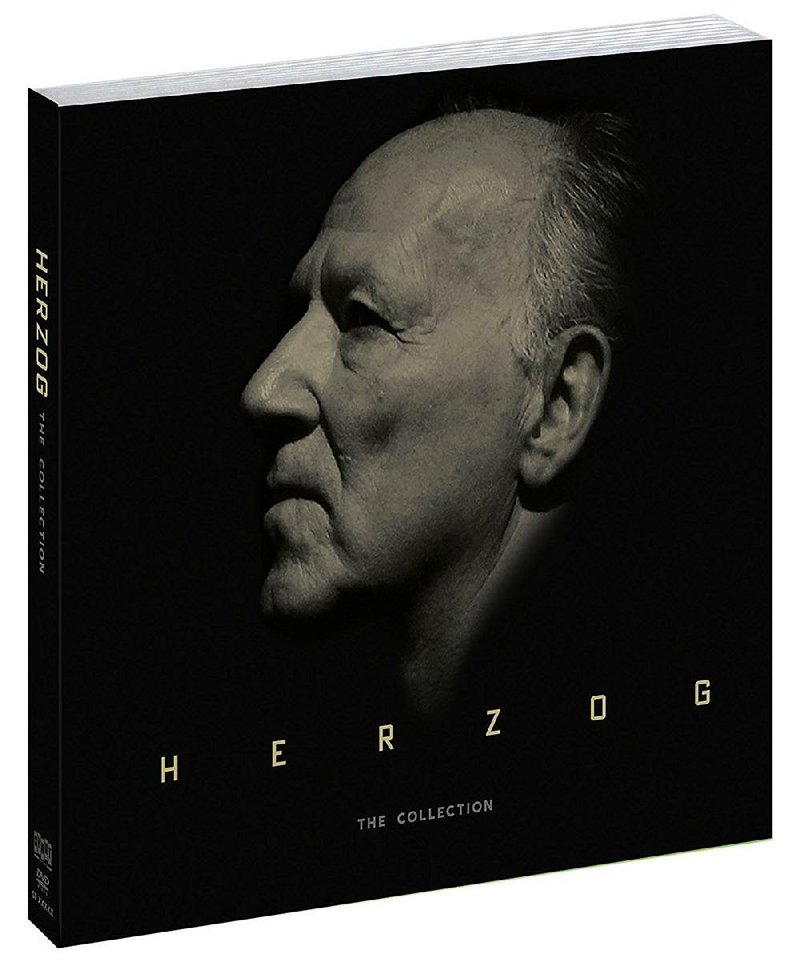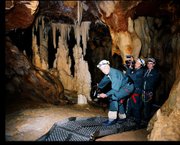"I believe the common denominator of the universe is not harmony but chaos, hostility and murder."
-- Werner Herzog, narrating his 2005 documentary Grizzly Man
Someone shot Werner Herzog. Of course they did.
It was in 2006, in the middle of an interview conducted by the BBC's Mark Kermode on the side of the road on a hillside overlooking Los Angeles, where Herzog had recently moved. Kermode says they set up outside to get an establishing shot of the Teutonic mystic "in his natural habitat."
"In Germany I've somehow left the paved road," Herzog says. "Nobody cares about my films. For example -- "
And pfft! A bullet -- maybe a pellet -- strikes him in the abdomen. "What was that?" he asks, almost bemusedly.
After the BBC camera crew determines that "some wacko" was shooting at them, they take the interview inside, where Herzog ultimately unbuttons his pants to reveal a small, bloody wound. "It's not a significant bullet," the director laughs. "It's not an everyday thing but it doesn't surprise me to be shot at."
(You can watch Kermode's interview -- and Herzog getting shot -- at bbc.co.uk/programmes/p031lbrw.)
It's a shame things like this happen to Herzog -- in the interview with Kermode he allows that he has been shot at before -- because more people know Herzog for his outsize personality and his risky exploits than his movies.
As a test I ask three friends I'd classify as film buffs to quickly name their favorite Herzog movie. Two of them immediately say Wings of Desire, which is a Wim Wenders film. The third stalls and finally offers, "The one about the cave in France that was in 3-D" -- 2010's Cave of Forgotten Dreams.
When I tell him he is the only person in my small sample who successfully names a Herzog film, my friend admits that the director is "not exactly a household name." He thinks most people might have a vague idea that Herzog is a German film director, but maybe not. Herzog sometimes seems more a product of our collective dream than a working artist, someone we might recognize for his voice and manner rather than the rigor of his vision.
Herzog is enough of a celebrity to voice a character on The Simpsons (he plays a German pharmaceutical industrialist who claims to have been Augustus Gloop, the gluttonous kid who falls into the chocolate river and is piped into the fudge room in Roald Dahl's Charlie and the Chocolate Factory). Typically for Herzog, he claims that when he was asked to voice the character he didn't know The Simpsons was a television series; he was under the impression it was a newspaper comic.
But while we might view that claim -- and a lot of Herzog's supposed naivete about the world at large -- as part of a larger strategy for curating his myth, the fact is the man has led an eventful life. He really did rescue Joaquin Phoenix after the actor's car overturned. (Animator Sascha Ciezata made a short film about the incident around Herzog's telling of the story, which Phoenix corroborated in an interview with The Guardian: "There's something so calming and beautiful about Werner Herzog's voice. I felt completely fine and safe. I climbed out. I got out of the car and I said, 'Thank you,' and he was gone." You can watch Ciezata's film at tinyurl.com/ycev6259.)
...
You might have heard Herzog is coming to this year's Hot Springs Documentary Film Festival.
This is quite a coup for the festival and for the University of Central Arkansas, where Herzog will hang out for a day as artist in residence on Oct. 5. Because Herzog, for all the interesting static that occasionally occludes his signal, is one of the world's master filmmakers, a genuine giant of world cinema. Francois Truffaut called him "the most important film director alive." Roger Ebert observed he "has never created a single film that is compromised, shameful, made for pragmatic reasons, or uninteresting. Even his failures are spectacular."
But if you want to understand Herzog, if you're looking to cram a little before his appearance in Hot Springs (we don't know what he'll be doing there yet, only that it's likely his first visit to Arkansas will be brief), the best place to start might be someone else's films, specifically two documentaries made by Les Blank: 1980's Werner Herzog Eats His Shoe -- a 21-minute short about Herzog living up to his promise to eat his shoe if Errol Morris ever finishes his film Gates of Heaven (the 1978 documentary that kick-started Morris' career and is now regarded as a classic. He went on to direct The Thin Blue Line, A Brief History of Time and Fast, Cheap and Out of Control, among others) -- and 1982's Burden of Dreams, which documents the making of Herzog's epic Fitzcarraldo and the director's tempestuous relationship with Klaus Kinski.
Always alert to and interested in perpetuating his self-mythology, Herzog made his own film about his relationship with Kinski. My Best Fiend -- the German title literally translates to "My Dearest Enemy," which would have been better -- was released in 1999 after Kinski's death. The actor appeared in five of Herzog's features, apparently not always willingly. In the film Herzog recounts how he once pulled a pistol on his leading man to keep him from leaving the set.
See these movies, then watch Burden of Dreams and 1972's Aguirre, the Wrath of God, which also stars Kinski and was shot in the Peruvian rain forest. Based on the true story of conquistador Lope de Aguirre and his expedition into the Amazon to find El Dorado, the film feels less like a fictionalized history than a map of the actor's descent into madness. Herzog's obsession with authentic locations and hazards coupled with Kinski's frighteningly raw performance (he terrified his co-stars and the crew during the shoot) make Aguirre a singular cinematic experience.
Francis Ford Coppola acknowledged Aguirre's "incredible imagery" as a major influence on Apocalypse Now, in which the journey of Martin Sheen's Capt. Willard parallels the Spaniard's. But not everyone was sold on Kinski's performance; one German critic wrote that Kinski was "nothing but a detriment to the film" and that he "looks as if he is comporting himself with extreme irritation" that "has led him to drink himself silly such that he's incapable of doing anything more than heaving up his left shoulder with his backwards-leaning torso."
It's significant that Aguirre and Fitzcarraldo are based on historical figures (so are 1979's Woyzeck and 1974's The Enigma of Kaspar Hauser) for Herzog has always done his best and most interesting work in the seams between journalism and invention. Even -- or perhaps especially -- in those films he calls documentaries, Herzog has always aimed for what he calls "ecstatic truth," the sort of existential affirmation available in poetry, as opposed to what he calls "the bookkeeper's truth." This means that Herzog has no qualms about telling a documentary subject what to say, or reshooting a scene to suit his vision.
The result is that some of his most accessible films have been his documentaries, like the previously mentioned Cave of Forgotten Dreams, an immersive, astonishing film about the oldest artworks known to man -- paintings that were discovered inside a French cave in 1994. But Herzog isn't content to report on the story of French spelunkers who followed a subtle air current and dug their way into one of the cave's chambers, where they found first a painting of a mammoth, then dozens of magnificent, artfully realized paintings of lions, bears, rhinos and horses. No, the director-narrator unspools an intriguing meditation on what one of the scientists interviewed identifies as homo spiritus -- man awakened to the timeless, transcendental power of art. It's suggested that the cave might be the birthplace of the human soul.
Some of Herzog's speculative discursions feel whimsical and dismissable, but in the end he manages to make a work of art out of a story about art. He accomplishes something of the same order in 2011's Into the Abyss, his meditation on murder and capital punishment that focuses on the fallout from a triple homicide that occurred in Conroe, Texas, in October 2001.
In the most striking moment from that film, the unseen Herzog reacts to a young killer's attempts to enlist his empathy by stating: "When I talk to you, it does not necessarily mean that I have to like you. But I respect you and you are a human being, and I think human beings should not be executed as simply as that."
In contrast, Herzog's recent fictional films like 2016's Salt and Fire (an environmental thriller that failed to gain any commercial traction), Nicole Kidman's 2015 vehicle Queen of the Desert and 2009's police procedural Bad Lieutenant: Port of Call feel relatively uninspired and strangely compromised. While Bad Lieutenant has gained a cult following, that's mostly because of the presence of hipster icons Nicolas Cage and Val Kilmer (whose completely superfluous part was created to give him an excuse to hang out with Herzog and Cage). While Herzog seems temperamentally incapable of making a genuinely dull movie -- he abhors shooting on sound stages and relying on digital trickery, which goes a long way to providing his movies with at least a pleasant scruffiness -- it's clear his heart now lies with his philosophical investigations of the real world.
Which is why it makes perfect sense that he's coming to Arkansas under the colors of a documentarian. Though given Herzog's history, perhaps hunter orange would be more appropriate.
Email:
blooddirtangels.com
Style on 09/24/2017


